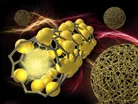IDTechEx: Report on Silicon Anode Market Forecast

The global silicon anode battery materials market will surpass US$15bn by 2035, driven by the demand for higher energy density and faster-charging battery technologies. Dr Alex Holland, Research Director at IDTechEx, said, “It is due to the need for higher energy density and faster charging battery technologies.” The battery electric vehicle (BEV) market is expected to be the primary catalyst for the surge, as silicon can significantly enhance these performance metrics.
Unlocking higher energy densities
Silicon anode technologies promise to achieve cell-level Li-ion energy densities exceeding 1000 Wh/l and 400 Wh/kg. Charging times could be reduced to as little as 10 minutes with next-generation silicon anode advancements.
Despite these benefits, silicon currently represents less than 2% of the Li-ion anode market by weight. “This is due to the substantial detrimental effect on cycle life and lifetime,” explains Alex. As a result, the primary use of silicon as an additive rather than a primary anode material.
Investment fuels technological progress
The IDTechEx report, Silicon Anode Battery Technologies and Markets 2025-2035: Players, Technologies, Applications, Markets, Forecasts, delves into the latest developments in silicon anode technologies. “Significant investment into the development of silicon anodes has driven technological progress, allowing silicon adoption at higher weight percentages and in a higher volume of batteries,” shares Alex.
The report highlights that production capacity for silicon anode materials is projected to grow 6.5x between 2024 and 2030.
China leads production, US and South Korea follow
Alex notes that China will dominate silicon anode material production, but the US and South Korea are making strides. “In the US, numerous pure-play silicon anode companies aim to produce commercial material at scale within the next few years,” he explains.
Some companies plan to establish US-based facilities to benefit from Inflation Reduction Act (IRA) credits. However, the long-term political commitment to supporting domestic EV and battery industries remains uncertain.
South Korea is rapidly becoming a hub for silicon anode activity, with players like Daejoo Electronic Materials and POSCO expanding their capabilities. “For example, Group14 Technologies commissioned the first of their 2 ktpa factories in Korea in September 2024 in a joint venture with SK Inc,” shares Alex.
UK-based Nexeon is setting up large-scale production facilities in South Korea, leveraging local silane gas supplies and access to the Korean battery industry.
Challenges and opportunities
While the future looks promising, challenges remain for the widespread adoption of silicon anode materials. “Difficulties range from technical hurdles to supply chain complexities,” points out Alex.
Additionally, the price premium for silicon materials should persist in the medium term. However, the robust long-term outlook for EVs, improved silicon anode technologies and expanded production capacities highlight the market’s growth potential.
Comprehensive insights in the IDTechEx Report
The IDTechEx report provides an in-depth exploration of the evolving silicon anode landscape.
“The report covers start-ups and established companies active in developing silicon anode materials,” states Alex. It offers forecasts segmented by silicon technology (silicon-additive, mid-silicon, high-silicon), application (battery electric cars, commercial EVs and electronic devices) and region (China, US, Europe and global).
With significant advancements and increasing investment, the silicon anode battery materials market is poised for transformational growth, redefining the future of energy storage technologies.
Explore the latest edition of EV Magazine and be part of the conversation at our global conference series, Sustainability LIVE and Manufacturing LIVE.
Discover all our upcoming events and secure your tickets today.
EV Magazine is a BizClik brand


